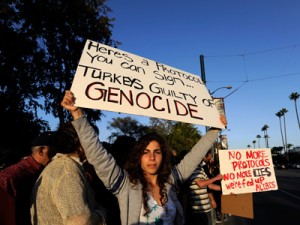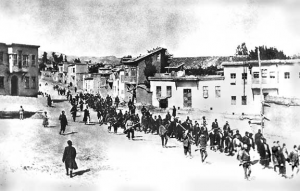Podcast: Play in new window | Download
Armenian Genocide Survivor Stories: 99 Years Later
Around the world, April 24 marks observance of the Armenian Genocide. On that day in 1915 the Interior Minister of the Ottoman Empire, Talaat Pasha, ordered the arrest and hangings of Armenian intellectuals and community leaders in Constantinople. The date is widely considered to be the starting date of a systematic and well-documented plan to eliminate the Armenians, who had been under Ottoman rule and treated as second class citizens since the 15th century.
As Armenians escaped to several countries, including the United States, a number came to New Britain, Connecticut in 1892 to work in the factories of what was then known as the hardware capital of the world. By 1940, nearly 3,000 Armenians lived there in a tight-knit community. Meeting together to share memories in conversation are Jennie Garabedian, Harry Mazadorian, Roxy Garabedian, Lucy Simonian, Roxie Maljanian, Mary Abrahamian, John Maljanian, Agnes Karanian, Ruth Swisher, and Artie Shahverdian.
The unspeakable and gruesome nature of the killings—beheadings of groups of babies, dismemberments, mass burnings, mass drownings, use of toxic gas, lethal injections of morphine or injections with the blood of typhoid fever patients—render oral histories particularly difficult. As you will hear from the stories of these first generation Armenian survivors who continue to live in New Britain, a shared history –a shared identity—emerges.
Why did this happen? Despite being deemed inferior to Turkish Muslims, the Armenian community had attained a prestigious position in the Ottoman Empire and the central authorities there grew apprehensive of their power and longing for a homeland. A concerted plan of deportation and extermination was allowed to be carried out, in large part because World War I demanded the involvement and concern of potential allied countries. As the writer Grigoris Balakian wrote, the war provided the Turkish government “their sole opportunity, one unprecedented” to exploit the chaos of war in order to carry out their extermination plan.
Some learned about the massacres directly from their parents or family members, while others were not told at all. Often, surviving women were ashamed to talk about what they had experienced because so many of them had been raped or forced into harems. For others, conjuring visual images of the atrocities was too painful to bear. When parents did speak about the crimes they experienced or witnessed, they frequently spoke in Turkish or Syrian, instead of English or Armenian, so that their children couldn’t understand. Most children of survivors say that the subject was a secret, even forbidden.
Please help support Law and Disorder, the show is now a sponsored project of Fractured Atlas, a non-profit arts service organization. Contributions for the charitable purposes of Law and Disorder must be made payable to Fractured Atlas only and are tax-deductible to the extent permitted by law.

